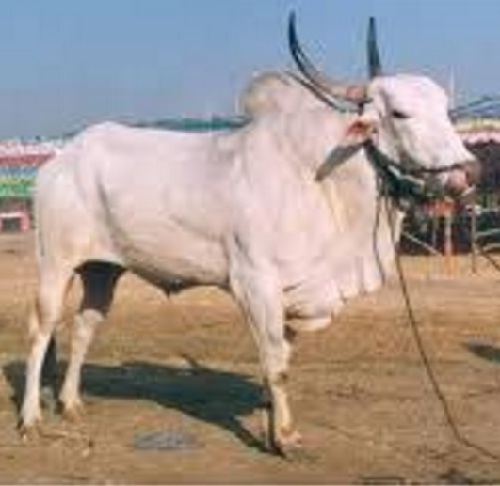 | ||
Similar Hallikar, Nimari cattle, Red Kandhari cattle, Kenkatha cattle, Gaolao cattle | ||
The Khillari (Kannada:ಖಿಲಾರಿ/Marathi:खिल्लारि) is breed of cattle, of the Bos indicus sub-species, native to Satara, Kolhapur and Sangli regions in Maharashtra and Bijapur, Dharwad and Belgaum districts of Karnataka in India. The breed is well adapted to the tropical and drought prone conditions present in the region and are favoured by the local farming community due to their ability to handle the hardships of farming. In spite of this, lately the breed is showing a steady decline in numbers mostly due the low milk yield which forms an alternate stream of income for the farming community.
Contents

Origin

The Khillari breed, with its several varieties, possibly owes its origin to the Hillikar breed of cattle from Mysore State or from the Maharashtra state. The name comes from "Khillar" meaning a herd of cattle, and Khillari meaning the herdsman.Mostly Khillari bulls are basically from Satara District of South Maharashtra.& also this animals are found in neighbouring districts of Sangli, Kolhapur & Solapur of Western Maharashtra.
Characteristics
The Khillari is between 4½ to 5½ feet tall and weighs between 800 and 1000 lbs.The typical Khillari animal is compact and tight skinned, with clean cut features and squarely developed hindquarters. The appearance is compact with stout strong limbs. The pelvis is slightly higher than the shoulders. The Khillaris of the Deccan plateau, the Mhaswad and the Atpadi Mahal types are greyish white in colour, the males having deeper colour over the forequarters and hindquarters, with peculiar grey and white mottling on the face. The Tapti Khillari is white with reddish nose and hooves. The Nakali Khillari is grey with tawny or brickdust color over the forequarters. Newly born calves have rust red coloured polls, but this disappears within a couple of months. Khillaris have a long narrow head with long horns sweeping back and then upward in a distinctive bow, and tapering to a fine point. The ears, coloured yellow inside are small, pointed and held sideways. The legs are round and straight with black hooves. The coat is fine, short and glossy.
Varieties
There are four principal types of Khillaris prevalent in the different regions of Maharashtra State. The variety Hanam Khillar, or sometimes known as Atpadi Mahal, is prevalent in southern Maharashtra .In the districts of Kolhapur and Satara and the adjoining areas the variety known as Mhaswad Khillari is mostly in Man & Khatav talukas of Satara District prevalent. In the area of the Satpura range of hills comprising the West Khandesh district the variety prevalent is known as Tapi Khillari or Thillari. A variety of more recent origin known as Nakali Khillari - Nakali means "imitation" - is found in adjacent areas of these regions.
Breeding
In the southern Maharashtra and the districts of Sholapur, Sangli and Satara the Khillaris are bred by cultivators. In these regions the size of the herd is small, usually not more than one or two cows. In the Satpura ranges the Khillaris are bred by professional breeders known as Thillaris. These breeders produce bulls and bullocks for which there is always a very good demand. Besides their extensive use in their home tracts they are used in the adjacent districts of Pune, Ahmednager, Nasik and Bijapur. Khillaris are classified as "medium fast draft". Breeding is carried out by the Government of Mahararashtra at Hingoli, Jath and Junoni and by the Government of Karnataka at Bankapur.
